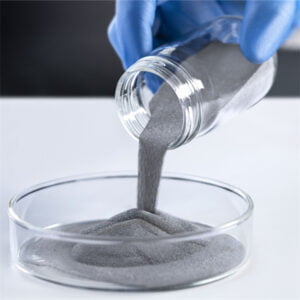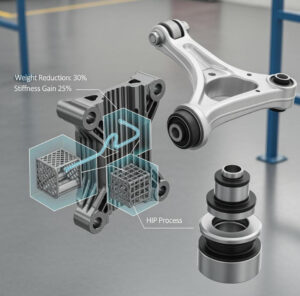3D-utskrift av metallpulver: Säkerställa säkerheten för plasmaatomisering
Innehållsförteckning
3D-utskrift av metallpulver har revolutionerat tillverkningen och gör det möjligt att skapa komplexa, anpassade delar med oöverträffad lätthet. Men denna innovativa process är starkt beroende av ett avgörande element: 3D-utskrift av metallpulver.
Detta fina metalldamm är byggstenen för många 3D-utskriftstekniker som Selective Laser Melting (SLM) och Electron Beam Melting (EBM). För att producera sådant metallpulver krävs dock en specifik teknik som kallas Plasmaatomiseringsom innebär intensiv värme och smält metall, vilket ger upphov till säkerhetsproblem.
Den här artikeln dyker djupt in i världen av Metallpulver för 3D-utskriftmed fokus på plasmaatomisering. Vi’kommer att utforska:
- Plasmaatomiseringens finesser: Vi kommer att bryta ner processen och belysa dess fördelar och begränsningar.
- Ett brett sortiment av metallpulver: Vi kommer att dyka in i egenskaperna och applikationerna för 10 olika metallpulvermodeller.
- Säkerhetsaspekter vid plasmaatomisering: Vi diskuterar potentiella risker och viktiga åtgärder för att säkerställa en säker arbetsmiljö.
- Vanliga frågor och svar (FAQ): Vi kommer att ta upp vanliga frågor om plasmaatomisering och säkerhet för metallpulver.
I slutet kommer du att få en omfattande förståelse för plasmaatomisering, dess roll när det gäller att skapa metallpulver för 3D-utskrifter och de viktiga stegen för att prioritera säkerheten under hela processen.
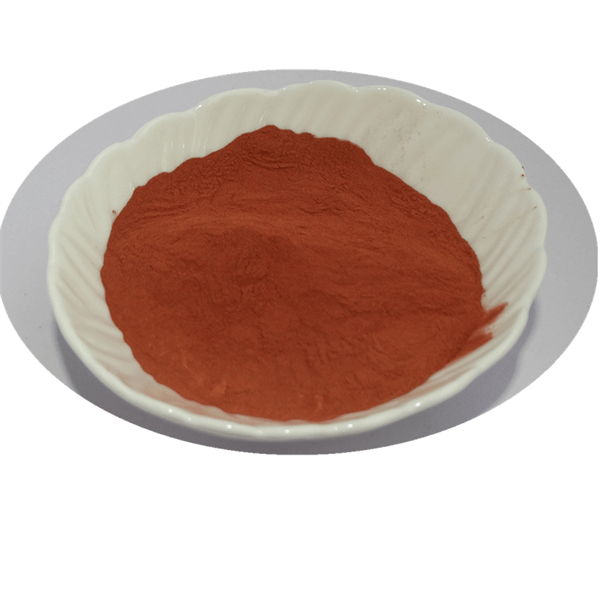
3D-utskrift av metallpulver: Förståelse av plasmaatomisering
Föreställ dig en högeffektiv fackla som omedelbart smälter metall och omvandlar den till en fin dimma av små droppar. Det är kärnan i plasmaatomisering. Här’är hur det fungerar:
- Förberedelse av råmaterial: Processen börjar med ett massivt metallgöt, som sedan hackas i mindre bitar.
- Plasmagenerering: En inert gas, vanligtvis argon, passerar genom en elektrisk båge och skapar en intensiv plasmaström med temperaturer över 10.000°C (18.000°F).
- Metallsmältning och atomisering: De smälta metallgötbitarna sprutas in i plasmaströmmen, vilket gör att de smälter omedelbart. Plasmat med hög hastighet bryter sedan sönder den smälta metallen till en fin spray av droppar.
- Solidifiering och uppsamling: När dropparna snabbt svalnar i den omgivande atmosfären stelnar de till enskilda metallpartiklar. Dessa partiklar samlas sedan upp och siktas för att få den önskade pulverstorleksfördelningen.
Fördelar med plasmaatomisering:
- Hög renhet: Miljön med inert gas minimerar kontaminering, vilket resulterar i metallpulver med hög renhet.
- Sfärisk morfologi: Den snabba kylningen främjar bildandet av sfäriska partiklar, idealiska för effektiva 3D-utskriftsprocesser.
- Brett utbud av material: Plasmaatomisering kan hantera ett stort antal metaller, inklusive reaktiva material och material med hög smältpunkt.
Begränsningar av plasmaatomisering:
- Energikrävande: Processen kräver betydande energi för att generera och upprätthålla den högtempererade plasmaströmmen.
- Dyr utrustning: Det kan vara dyrt att installera och underhålla utrustning för plasmaatomisering.
- Säkerhetsfrågor: De höga temperaturerna och de farliga materialen kräver strikta säkerhetsåtgärder för att skydda arbetarna.
Utforska spektrumet av metallpulver
Låt oss nu utforska ett brett urval av metallpulver som vanligtvis används vid 3D-utskrift av metallpulver, var och en med unika egenskaper och applikationer:
1. Rostfritt stål 316L: Detta mångsidiga, korrosionsbeständiga pulver används ofta inom flyg- och rymdindustrin, medicinsk utrustning och allmänna tekniska tillämpningar.
2. Titan klass 2: Detta lätta, höghållfasta pulver är idealiskt för biomedicinska implantat, flyg- och rymdkomponenter och sportartiklar tack vare sin utmärkta biokompatibilitet och styrka i förhållande till vikt.
3. Inconel 625: Detta högtemperaturlegerade pulver erbjuder exceptionellt motstånd mot oxidation och korrosion, vilket gör det lämpligt för komponenter i jetmotorer, kemisk processutrustning och värmeväxlare.
4. Aluminium Si7Mg0,6: Detta lätt svetsbara pulver ger en bra balans mellan styrka och duktilitet, vilket gör det populärt för fordonskomponenter, konsumentelektronik och arkitektoniska applikationer.
5. Koppar: Detta pulver med hög ledningsförmåga är värdefullt för elektriska komponenter, värmeväxlare och applikationer som kräver hög värmeledningsförmåga.
6. Nickel: Detta mångsidiga pulver används inom elektronik, batterier och kemisk bearbetning tack vare sin utmärkta korrosionsbeständighet och sina katalytiska egenskaper.
7. Koboltkrom (CoCr): Detta biokompatibla pulver är ett populärt val för ortopediska implantat och tandproteser på grund av dess höga slitstyrka och hållfasthet.
8. Tungsten: Detta pulver med hög densitet och hög smältpunkt används i applikationer som kräver extrem hållbarhet och värmebeständighet, t.ex. pansarplätering och svetselektroder.
9. Niobium: Detta supraledande pulver, som ofta används i kombination med andra metaller, uppvisar noll elektriskt motstånd vid extremt låga temperaturer, vilket gör det avgörande för högpresterande magneter och medicinsk bildutrustning.
Bedömning av potentiella säkerhetsrisker
Även om plasmaatomisering erbjuder många fördelar för att producera högkvalitativa metallpulver, är det viktigt att känna till de inneboende säkerhetsrisker som är förknippade med processen. Här är några viktiga problemområden:
- Höga temperaturer: Den intensiva värme som genereras vid plasmaskapande (över 10 000 °C) utgör en betydande brandrisk. Oavsiktliga spill eller fel på utrustningen kan leda till brännskador eller till och med explosioner om de inte hanteras enligt korrekta säkerhetsprotokoll.
- Farliga material: Processen innebär ofta hantering av potentiellt farliga material, t.ex. tungmetaller och brandfarliga gaser. Inandning av metalldamm eller exponering för skadliga ångor kan orsaka andningssvårigheter och andra hälsoproblem för arbetstagarna.
- Bullerföroreningar: Plasmagenereringsprocessen skapar ett högt och gällt ljud som kan överskrida säkra bullernivåer och skada arbetarnas hörsel om inte adekvat skydd används.
- Risk för explosion: Fel på utrustningen eller felaktig hantering av brandfarliga gaser kan leda till en potentiell explosion som kan orsaka allvarliga personskador eller skador på egendom.
Tillhandahållande av säkerhetsrutiner och skyddsåtgärder
För att minska dessa risker och säkerställa en säker arbetsmiljö för all personal som arbetar med plasmaatomisering måste strikta säkerhetsprotokoll implementeras. Dessa inkluderar:
- Tekniska kontroller: Genom att använda slutna system, ventilationssystem och fjärrstyrning när så är möjligt kan man avsevärt minska exponeringen för farliga material, värme och buller.
- Personlig skyddsutrustning (PPE): Att utrusta medarbetarna med lämplig personlig skyddsutrustning, t.ex. värmetåliga kläder, andningsskydd och hörselskydd, är avgörande för att minimera risken för skador och hälsoproblem.
- Regelbundet underhåll och inspektion: Att regelbundet inspektera och underhålla utrustningen är viktigt för att identifiera och åtgärda eventuella fel innan de uppstår.
- Säkerhetsträning och utbildning: Omfattande utbildningsprogram bör tillhandahållas all personal som är involverad i processen och omfatta säkra driftsprocedurer, nödprotokoll och identifiering av faror.
- Skyltning och märkning: Korrekt skyltning och märkning ska användas för att tydligt identifiera potentiella faror och säkerhetsinstruktioner i hela arbetsområdet.
Genom att följa dessa säkerhetsåtgärder och främja en kultur av säkerhetsmedvetenhet kan plasmaatomiseringsanläggningar minimera riskerna och bedriva en ansvarsfull verksamhet som skyddar både de anställda och den omgivande miljön.
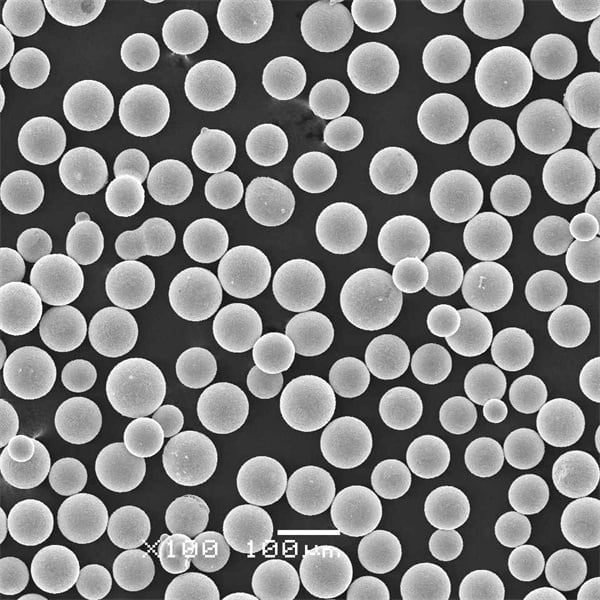
Vanliga frågor
1. Är plasmaatomisering miljövänlig?
Även om plasmaatomisering erbjuder betydande fördelar när det gäller att producera rena och högkvalitativa metallpulver, har den en miljöpåverkan. Processen förbrukar mycket energi och bidrar till utsläppen av växthusgaser. Dessutom kräver hanteringen av farliga material strikta regler och korrekta avfallshanteringsmetoder för att minimera miljöförstöringen.
2. Hur varierar kostnaden för olika metallpulver?
Kostnaden för metallpulver kan variera avsevärt beroende på flera faktorer, bland annat:
- Kostnaden för råmaterialet: Priset på basmetallen spelar en stor roll för den slutliga kostnaden för pulvret. Ädelmetaller som guld eller platina är till exempel naturligtvis dyrare än vanliga metaller som järn.
- Komplexiteten i produktionsprocessen: Mer komplexa processer som plasmaatomisering, jämfört med enklare metoder som gasatomisering, leder ofta till högre produktionskostnader, vilket återspeglas i det slutliga priset på pulvret.
- Marknadens efterfrågan och utbud: Efterfrågan och tillgången på specifika metallpulver kan också påverka deras kostnad. Om efterfrågan är hög och tillgången begränsad kommer priset sannolikt att vara högre.
3. Vilka är de framtida trenderna inom plasmaatomiseringsteknik?
Framtiden för plasmaatomiseringstekniken förväntas innebära framsteg inom flera områden:
- Energieffektivitet: Forsknings- och utvecklingsinsatserna syftar till att förbättra processens energieffektivitet för att minska miljöpåverkan och driftskostnaderna.
- Automation: Ökad automatisering i plasmaatomiseringsanläggningar kan förbättra säkerheten, konsekvensen och produktionseffektiviteten.
- Utveckling av nya material: I takt med att efterfrågan på avancerade material inom olika branscher ökar förväntas plasmaatomisering spela en avgörande roll för att producera kundanpassade och högpresterande metallpulver för dessa applikationer.
Genom att ta itu med potentiella säkerhetsproblem, kontinuerligt förbättra tekniken och utforska dess fulla potential för att producera olika metallpulver, kommer plasmaatomisering att förbli ett viktigt verktyg i den ständigt föränderliga världen av 3D-printing och avancerad tillverkning.
Dela på
MET3DP Technology Co, LTD är en ledande leverantör av lösningar för additiv tillverkning med huvudkontor i Qingdao, Kina. Vårt företag är specialiserat på 3D-utskriftsutrustning och högpresterande metallpulver för industriella tillämpningar.
Förfrågan för att få bästa pris och anpassad lösning för ditt företag!
Relaterade artiklar
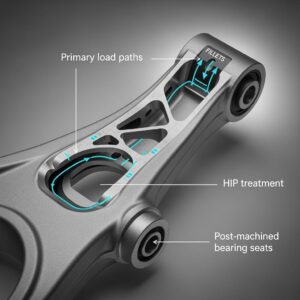
Metal 3D Printing for U.S. Automotive Lightweight Structural Brackets and Suspension Components
Läs mer "Om Met3DP
Senaste uppdateringen
Vår produkt
KONTAKTA OSS
Har du några frågor? Skicka oss meddelande nu! Vi kommer att betjäna din begäran med ett helt team efter att ha fått ditt meddelande.














